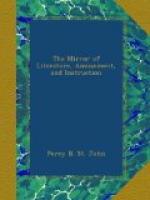Among the introductions, or new faces, we noticed a pair of fine mastiffs from Cuba, and two Thibet watch-dogs. One of the latter stood shivering in the cold, with bleared eyes, and crying “like a lubberly postmaster’s boy.” The three bears exhibited as much good-breeding as the visiters encouraged,—climbing to the top of the pole when there was any thing to climb after, and an Admiralty expedition could do no more.
Poisoning of Vegetables.
Several very curious experiments on the poisoning of vegetables, have recently been made by M. Marcet, of Geneva.—His experiments on arsenic, which is well known to every one as a deadly poison to animals, were thus conducted. A vessel containing two or three bean plants, each of five or six leaves, was watered with two ounces of water, containing twelve grains of oxide of arsenic in solution. At the end of from twenty-four to thirty-six hours, the plants had faded, the leaves drooped, and had even begun to turn yellow; the roots remained fresh, and appeared to be living. Attempts to restore the plants after twelve or eighteen hours, by abundant watering, failed to recover them. The leaves and stem of the dead plant gave, upon chemical examination, traces of arsenic. A branch of a rose-tree, including a flower, was gathered just as the rose began to blow; the stem was put into a vessel, containing a solution of six grains of oxide of arsenic in an ounce of water. The flower and leaves soon showed symptoms of disease, and on the fifth day the whole branch was withered and dead, though only one-fifth of a grain of arsenic had been absorbed. Similar stems, placed in pure water, had, after five days, the roses fully expanded, and the leaves fresh and green.




